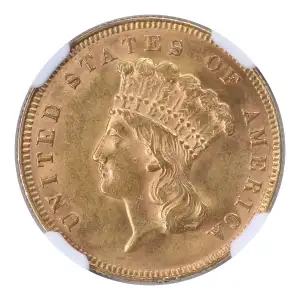In 1845, the United States introduced the first postage stamps at a rate of five cents each. In 1851, the postage rate was decreased to three cents, and Congress authorized the coinage of the tiny silver three-cent piece as a convenient option for purchasing stamps. This logic was expanded in 1853 with the introduction of the $3 gold piece. It was hoped that the large new coin would facilitate the purchase of 3-cent stamps by the sheet and of 3-cent coins by the roll. Chief Engraver James B. Longacre chose an Indian Princess motif for the obverse of the new coin-- a profile modeled after the Greco-Roman Venus Accroupie statue on display in the Philadelphia museum. On this coin, Miss Liberty wears a feathered headdress of equal-sized plumes with a band inscribed with LIBERTY. This headdress dates to the earliest known drawings of American Indians. The reverse depicts a wreath of tobacco, wheat, corn, and cotton with a plant at the top bearing two conical seed masses. Encircled by the wreath, is the denomination 3 DOLLARS and the date. Despite a lifespan of 35 years, the three-dollar gold piece never lived up to initial expectations and was generally met with a lukewarm reception by the public. Mintage figures were generally low, and by all accounts, most dates of 3-dollar gold pieces can be considered scarce or rare today. Very few mint-state or proof quality specimens survive, and decent examples of any grade are sought after by collectors.


